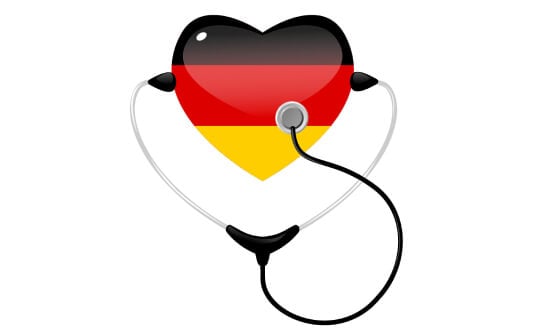Mitral valve disease is a lesion of the bicuspid valve and subvalvular structures, leading to impaired hemodynamics and the development of heart failure. Asymptomatic valvular heart disease is present in 2.5% of the population, increasing to 13% with age. In the absence of competent treatment, mitral valve dysfunction significantly reduces the quality and expectancy of life.
The European Society of Cardiology and the American Heart Association regularly investigate the effectiveness of the new surgical treatment methods and reflect the results of their research in the international guidelines. Today, minimally invasive surgery is the most effective and safe treatment method for patients with mitral valve disease.
Content
- Causes of mitral valve diseases
- Approaches to the treatment of mitral valve disease
- The da Vinci surgical system – a combination of a surgeon’s experience and robotic precision
- NeoChord – chordae tendineae plastic surgery on a beating heart
- The MitraClip – sparing one-step reconstruction of mitral valve leaflets
- Mitralign – an excellent alternative to drug treatment in patients with the high operational risk
- Hospitals and prices
- The competent choice of a hospital and cardiac surgeon is the basis of successful treatment
Causes of mitral valve diseases
The disease can be caused by fundamentally different defects in valve structures. In order to select an effective treatment strategy, it is important to accurately determine the type of the defect and the cause of its development.
- Defects of valve leaflets often occur in infectious endocarditis, myocarditis, and rheumatic heart diseases. Perforated, incompletely closed leaflets are not able to hold blood in the left ventricle during heart contractions. The blood leaks back into the left atrium and then into the lungs.
- Fusion of valve leaflets. The most common cause of mitral stenosis is rheumatism (acute rheumatic fever). Less often, this defect develops after infectious endocarditis or heart injuries. Interconnected, calcined leaflets impede the normal flow of oxygen-rich blood into the left ventricle and then to the tissues and organs.
- Rupture of chordae tendineae most often occurs in systemic diseases of the connective tissue and acute endocarditis. The valve leaflets displace (prolapse) into the atrial cavity, reducing the heart efficiency.
- Rupture or sclerosis of the papillary muscles is an acute, life-threatening condition when an infarction of the papillary muscles arises against the background of coronary heart disease (CHD) and heart tumors. In the lesion of papillary muscles, valve leaflets lose their fixation point, and the valve stops functioning completely.
Approaches to the treatment of mitral valve disease
The first step in the treatment of a clinically significant mitral valve disease is drug therapy. It includes drugs that slow down the heart beating and reduce the strength of its contractions (beta-blockers), antiplatelet and anticoagulant therapy, and antibacterial and anti-inflammatory drugs in infectious etiology of the defect. Drug therapy improves a patient's condition to a certain extent, but only qualitative surgical repair of the mitral valve can radically eliminate the cause of the disease.
Depending on the type of the defect, cardiac surgeons use one of the following procedures:
- Annuloplasty is a replacement or reconstruction of the support ring which surrounds the mitral valve and securely fixes it between the left atrium and the ventricle.
- Chordae plastic surgery is a restoration of the integrity of damaged chordae tendineae or their length.
- Commissurotomy is the surgical separation of fused valve leaflets.
- Plastic surgery of valve leaflets is a correction of the shape, size, or anatomical position of the valve leaflets.
- Replacement surgery is a complete replacement of the damaged mitral valve with a biological or mechanical prosthesis.
According to the multicenter clinical research and practical experience of leading cardiac surgery centers, the preference is given to robotic surgery using the da Vinci Surgical System and catheter surgical techniques.
The da Vinci surgical system – a combination of a surgeon’s experience and robotic precision
Using the da Vinci surgical system, robotic surgery is used for successful reconstructive surgery and total mitral valve replacement. Such interventions combine the advantages of minimally invasive surgery and high precision of manipulations due to the computer control of endoscopic instruments.
While using the da Vinci robot, the patients receive several significant advantages, such as:
- Shorter hospitalization period (up to 7 days).
- Shorter stay in the intensive care unit.
- Low risk of hemorrhage, no need for blood transfusion and its components.
- Low risk of reactive postoperative pericarditis and pleurisy.
- Fast recovery of physical activity (in a day after the surgery, the patient can move within the hospital).
- Invisible postoperative scars 1-2 cm in size, avoiding thoracotomy.
The experience of the da Vinci robot practicing lasts for over 20 years. During this time, the system has undergone a number of modifications that allow for improving the functional and aesthetic treatment results. In modern cardiac surgery centers, the latest modification of the robot is used – da Vinci Xi®. Today it is the only robotic device approved by the FDA for operations on the mitral valve.
The relative limitations of the da Vinci surgical system include high costs of equipment and the small number of qualified heart surgeons who are skilled in working with it. Also, the endoscopic interventions are not performed in patients with pulmonary hypertension, aortic stenosis or failure, or impaired liver function.
NeoChord – chordae tendineae plastic surgery on a beating heart
The development of the NeoChord DS1000 system resulted from numerous clinical researches that have demonstrated that the mitral valve plastic surgery is prior to its total replacement. NeoChord DS1000 is successfully used for plastic surgery of the chordae tendineae in patients with severe mitral insufficiency due to the mitral valve prolapse.
The procedure is performed under general anesthesia through a minithoracotomy access (the incision length is no longer than 5-6 cm). At the same time, the patient is not connected to the heart-lung machine, and the heart preserves its natural rhythm.
The NeoChord DS1000 system is inserted into the left ventricle under the strict control of 2D or 3D transesophageal echocardiography. A cardiac surgeon replaces the injured chordae with an artificial one and controls its tension. At the same time, the movement of the valve leaflets is displayed on the monitor of the echocardiograph in real-time mode. It allows the doctor to evaluate the result of the operation immediately and, if necessary, correct the position or tension of the chordae.
Today, the NeoChord procedure has been successfully performed in more than 1,000 patients in Europe and the USA. The results of long-term postoperative follow-up care confirm the safety of the technique and its effectiveness in the correction of mitral valve prolapse.
The MitraClip – sparing one-step reconstruction of mitral valve leaflets
The MitraClip technology is also used in terms of the approach "Respect when you can, resect when you should," which demonstrates that the reconstruction of the patient’s native mitral valve is prior to replacing it with a prosthesis.
The MitraClip system allows the doctors to reliably connect the deformed or damaged valve leaflets using a microsurgical clamp made of strong and metabolically inert metals, such as cobalt and chromium. During the procedure, the MitraClip is inserted into the femoral vein and, under the control of echocardiography, is moved to the left atrium. This method of inserting a catheter into the heart does not require thoracotomy and significantly reduces operational risks.
MitraClip reliably fixes the valve leaflets in the desired position, restoring normal blood flow from the left atrium to the ventricle. With the help of intraoperative echocardiography, a cardiac surgeon immediately evaluates the quality of the reconstructed valve and, if necessary, installs an additional clip.
Due to the successful results of clinical research (European researches COAPT and EVEREST II), the MitraClip technique was included in the updated medical guidelines for surgical treatment of mitral insufficiency. The MitraClip system is recommended for elderly patients with high operational risks. Such an operation is more easily tolerated compared to classic open cardiac surgery but cannot fully replace a comprehensive mitral valve reconstruction.
Mitralign – an excellent alternative to drug treatment in patients with the high operational risk
Mitralign is a patented system of minimally invasive mitral valve plastic surgery which simulates a direct surgical reduction of its extended ring. The mitral valve ring is the place of its fixation on the heart walls. If the ring is enlarged, the valve expands and becomes unable to reliably close the opening between the atrium and the ventricle during the heart contraction (systole). Functional mitral valve insufficiency, or mitral regurgitation, develops in such a situation.
The percutaneous annuloplasty system Mitralign consists of eight endoscopic devices, such as guide and transport catheters, suture material, and a microsurgical scalpel. The system is delivered to the left heart in an endovascular manner through a small incision in the femoral vein. Some devices are located in the left atrium, and the others are located in the left ventricle. Such system placement makes it possible to comfortably impose two pairs of clips on the extended mitral valve ring. At the same time, the folds are formed from the ring tissues. Thanks to it, the area is effectively reduced, and the normal function of the mitral valve is restored.
The entire procedure is carried out under the strict control of the intraoperative 3D echocardiography. Thanks to low operational risks, the Mitralign system is approved for use in patients with dilated cardiomyopathy and congestive heart failure. Considering the novelty of the procedure, its safety and long-term efficacy are to be further studied in the ongoing clinical trials.
Hospitals and prices
Two main points are important for successful minimally invasive mitral valve reconstruction. These are the availability of equipment and sufficient experience of the surgeon. Among the multidisciplinary and cardiological hospitals that accept patients from all over the world, the following are worth noting:
- University Hospital Oldenburg, Department of Cardiac Surgery
- University Hospital Essen, Department of Cardiothoracic Surgery
- University Hospital Ulm, Department of Cardiothoracic Surgery
- University Hospital Frankfurt am Main, Department of Cardiothoracic Surgery
- University Hospital Tuebingen, Department of Adult and Pediatric Cardiothoracic Surgery
The average cost of treatment is as follows:
- Diagnostics of mitral valve insufficiency or prolapse – €2,530
- Treatment of mitral valve insufficiency or prolapse with minimally invasive reconstruction – €43,770
- Treatment of mitral valve insufficiency or prolapse with minimally invasive prosthetics – €43,660
- Treatment of mitral valve insufficiency or prolapse using the Mitralign system – €38,635
- Treatment of mitral valve insufficiency or prolapse using the Carillon system – €38,680
- Cardiological rehabilitation – €1,460
The exact cost of treatment can be determined after the initial consultation, assessment of the patient's condition, and the choice of surgical technique. Also, the cost of treatment depends on the presence of concomitant diseases and the need for rehabilitation after completing the main course of treatment.
The competent choice of a hospital and cardiac surgeon is the basis of successful treatment
Among key points of a successful intervention on the mitral valve are the thorough preoperative examination and proper selection of an appropriate surgical technique. It is only possible in the conditions of a specialized cardiac surgery center or a large multidisciplinary hospital at the university level where the doctors are not limited in equipment for carrying out innovative interventions. Hospitals in European countries with developed healthcare systems can often offer such options.
If you choose a prestigious hospital abroad, you should take into account the specifics of making an appointment for foreign patients, the need to receive the invitation from the hospital, the preparation and translation of medical documentation, possible waiting for hospitalization for several months, paying for medical services at a higher rate, and so on. You can use the services of the company Booking Health in order to pass through all the stages of the medical program as comfortably and safely as possible.
The company Booking Health is the only medical tourism operator in the world, which has been organizing the treatment of patients from 75 countries in the leading hospitals for more than ten years. Our specialists will help you in such important aspects as:
- Choosing the right clinic based on the annual qualification profile
- Establishing communication directly with your doctor
- Preparing medical program in advance, without repeating previous examinations
- Providing favorable costs without overpricing and additional coefficients for foreign patients (saving up to 50%)
- Booking the appointment on the necessary date
- Monitoring medical programs at all stages
- Help in buying and forwarding medicines
- Communication with the clinic after treatment completion
- Control of invoices and return of unspent funds
- Organization of additional examinations
- Offering service of the highest level: booking hotels and plane tickets, transfer organization
Please, leave a request with medical and contact information on the official website of Booking Health, and a competent medical consultant or medical coordinator will contact you the same day.
Choose treatment abroad and you will for sure get the best results!
Authors:
The article was edited by medical experts, board certified doctors Dr. Nadezhda Ivanisova, Dr. Sergey Pashchenko. For the treatment of the conditions referred to in the article, you must consult a doctor; the information in the article is not intended for self-medication!
Sources:
Read:
Why Booking Health - questions and answers
How to make right decision when choosing the clinic and specialist
7 reasons to trust to the rating of clinics on the Booking Health portal
Don't know where to start?
Contact Booking Health







